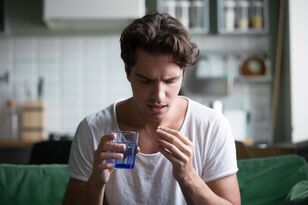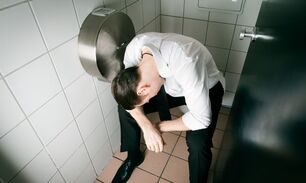Prostatitis is one of the most common urological diseases, in which an inflammatory process that covers the tissues of the prostate develops. Prostatitis can manifest itself in men of all ages and is usually accompanied by other diseases of the reproductive system. The causes of prostatitis in men can be different and, to reduce the likelihood of developing this disease, they must be considered in more detail.
Classification

Regarding the development of the pathological process, there are three main forms of prostatitis:
- Sharp.Symptoms appear suddenly and are more pronounced. Therefore, most men with an acute course of prostatitis go to the doctor in the early days of the open course of the procedure. A typical symptom of the disease is severe low back pain, which occurs in the context of an increase in body temperature to 39 degrees. Most of the time, the cause of prostatitis is an infectious focus, which can develop in distant organs.
- Chronic.If acute prostatitis is not treated in time, the disease turns into a chronic form. It is characterized by less pronounced symptoms, and the patient's general condition can be considered satisfactory. The temperature drops to normal limits.
- Stagnant.Non-infectious inflammatory process. It is caused by stagnation processes observed in Organs pelvic organs. The disease is characterized by progressive development with gradual increase in pathological symptoms. Today, this form of the disease is extremely rare.
The chronic form of the disease is considered to be very dangerous, as most men ignore mild symptoms, postponing consultation with the specialist. With this approach, it is possible to develop numerous complications of the disease.
The disease "got younger" over time, so it can occur at any age.
What causes prostatitis?
This disease develops in a third of men aged between 20 and 60 years. Therefore, unlike many diseases of the genitourinary system, this disease cannot be called age-related. There are several causes of prostatitis in men, the main of which will be discussed below.
Acute and chronic infections
Infectious injuries are the leading cause of prostatitis. When the infection enters the prostate, an inflammatory process occurs. Most of the time, diseases such as gonorrhea and urethritis become the cause of these forms of prostatitis.
Pathological processes, such as caries, tonsillitis, tuberculosis, etc. , can cause the development of infectious prostatitis.
To cure this form of the disease, it is necessary to eliminate the infectious agent that has become the main cause of its development. Only after the main causative agent of the infection has been neutralized can prostatitis be completely cured.
Congestion

Every man should have enough sex in life - otherwise, he will not run away from prostate problems.
The consequence of a lack of regular sexual life may be the development of congestion in the prostate. At the same time, blood circulation in the organ is disturbed, which results in stagnation of the secret, interrupting its functioning. All of this can lead to deformation of the prostate and the development of the inflammatory process.
Regular sexual activity helps to prevent stagnation of prostate secretions. In addition, experts recommend that your patients avoid promiscuous relationships by finding a permanent sexual partner.
Sedentary work
In recent decades, there has been an acute trend of transition from manual to mental work. And it is a sedentary lifestyle that is a major cause of prostatitis in men.
In addition, a sedentary lifestyle leads to a deterioration in the functions of the nervous, endocrine and cardiovascular systems. As a result, prostate cells receive less oxygen, which leads to the creation of ideal conditions for the reproduction of pathogenic microflora.
Although sedentary work is not a direct cause of prostatitis, it creates the ideal conditions for prostate infection. Therefore, to prevent prostatitis, the body must provide regular physical activity.
When leading an active lifestyle, a person's blood flow normalizes and the endocrine and nervous systems work better. Therefore, prostate tissues are protected from lack of oxygen.
Prolonged withdrawal
In the absence of regular sexual activity, secretion is stagnant in the organ. Therefore, blood circulation in the prostate tissues is difficult. The result is the same as a passive lifestyle.
The lack of oxygen leads to the fact that in the prostate tissues there are ideal conditions for the reproduction of pathogenic microflora. As a result, only a weak infection of the body will be sufficient to guarantee the guaranteed development of prostatitis.
Hypothermia

Freezing is a sure path for the onset of pathology.
Scientists argue that hypothermia is one of the main factors causing the development of prostatitis. Hypothermia prostatitis develops for several reasons:
- Due to hypothermia, vasoconstriction occurs, which leads to weakened tissue nutrition and impaired organ function.
- With a significant freezing of the body, a person's immune system is weakened. This leads to the fact that the body becomes susceptible to various types of infectious injuries.
Hypothermia is especially dangerous for men who have previously developed prostatitis. Even if the disease has been treated, it can still recur.
To prevent the development of prostatitis, it is necessary to dress well in the cold season, to avoid sitting on cold and cold surfaces. It is also prohibited to walk barefoot on an insufficiently hot floor.
Other reasons
The development of prostatitis can occur not only for the reasons above, but also under the influence of such factors:
- obesity;
- poor working conditions, heavy load in the perineal region or significant tremor;
- hormonal disorders;
- ARVI transferred to the legs;
- Chronic constipation.
The best prevention of this disease is to avoid the above factors. Men who have had prostatitis are especially susceptible to the development of this disease.
Who is at risk
Anyone who has had previous prostate problems can face the disease again.
Having considered what causes prostatitis, it is necessary to determine the group of people predisposed to its appearance. The following men are susceptible to prostatitis:

- leading a sedentary lifestyle;
- suffers from frequent constipation; obese
- ;
- engaged in sedentary work;
- subject to severe stress and heavy physical work;
- have irregular sex or frequently change sexual partners;
- has had prostatitis previously;
- suffering from immunological disorders;
- alcohol and cigarette users.
Developmental characteristics in young and elderly
Prostatitis can develop in young people due to several factors. The main ones are: sedentary work, lack of a full intimate life, a sedentary lifestyle. To minimize the development of this disease, you must exclude these factors from your life.
In the elderly, the disease develops more frequently in the context of the extinction of sexual function. As the body ages, the reproductive system undergoes changes, as a result of which, sooner or later, it stops working. A notable decline in fertility is seen in men aged 45-50 years.
In addition, it can occur under the influence of hormonal changes in the body, due to which the volume of testosterone production decreases. And these changes are one of the main causes of prostatitis.
Reasons for the transition from the acute stage of the disease to the chronic stage
Although acute prostatitis is characterized by vivid symptoms, forcing the patient to consult a specialist, the chronic form generally does not show characteristic symptoms. In most cases, men are in no hurry to see the doctor, noticing slight discomfort. As a result, the disease develops in more serious forms.
But how does the disease become chronic? Most of the time, an acute form of the disease that is insufficiently treated becomes the cause of the development of a chronic process. In this case, the transition from one form to another occurs under the influence of the following factors:
- Treatment started late.
- Ineffective therapy has been administered or the wrong technique has been chosen.
- The patient's immune response decreased significantly.
- There was no treatment for acute prostatitis.
It should be understood that the asymptomatic chronic course of the inflammatory process, sooner or later, ends with an exacerbation. Then, the patient shows all signs of the disease, including severe pain in the perineum and lower back, difficulty urinating and depression of sexual function.
Chronic prostatitis has an important characteristic: when primary inflammation of the prostate occurs, there is a deterioration in the innervation of this organ. This, in turn, has an extremely negative effect on your work, often causing autoimmune processes. In that case, the immune system starts to produce antibodies against the prostate tissue. Therefore, even if the primary infection is eliminated, it will not be possible to prevent the progression of this prostatitis.
Symptoms

The main symptom of the development of prostatitis is pain. This indicates that an inflammatory process develops in the prostate. In that case, the unpleasant sensations may be of a different nature and intensity. Urination causes severe pain.
This disease is especially uncomfortable, being in the acute stage of its development. In a context of severe pain, the patient has sleep disorders, his performance is significantly reduced, as well as the overall quality of life.
Pain in prostatitis has the following characteristics:
- located in the perineum, lower abdomen, lower back;
- radiate to the genital area;
- unpleasant sensations intensify when going to the bathroom, during arousal and during the ejaculation process;
- are accompanied by sexual dysfunction.
Erection problems are a common symptom of a chronic form of the disease. Due to the fact that such dysfunctions can have varying degrees of manifestation, then your therapy has some differences.
It is not uncommon for men to have a slow erection with prostatitis. Most patients fail to complete intercourse, or ejaculation is premature. These disorders negatively affect sperm composition.
Treatment methods
The specific type of therapy is determined by a specialist based on the characteristics of the course of the disease. In this case, the reasons for the development of this disease must be taken into account. Therefore, the main method of treating the acute form of the disease is antibiotic therapy. These drugs are taken even if the disease is not bacterial.
Complex treatment is provided for chronic prostatitis. It includes the following procedures:
- drug therapy; physiotherapy;
- taking immunomodulators;
- prostate massage.
If chronic prostatitis is non-bacterial in nature, it is treated with non-steroidal drugs. Sedatives are used as an additional treatment.
Prevention of prostatitis is reduced to an active lifestyle, regular sex with a regular partner and timely treatment of infectious diseases.
























